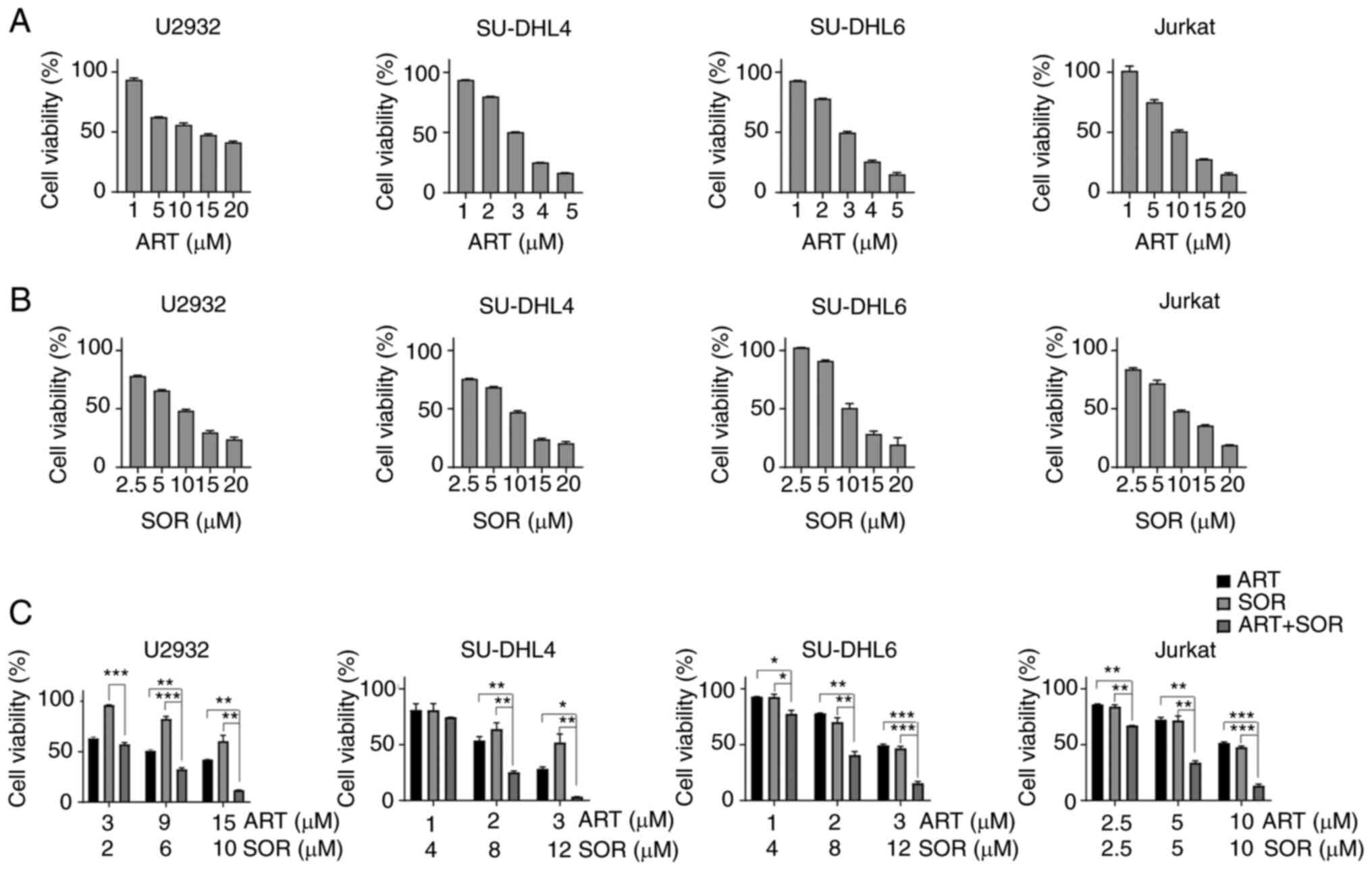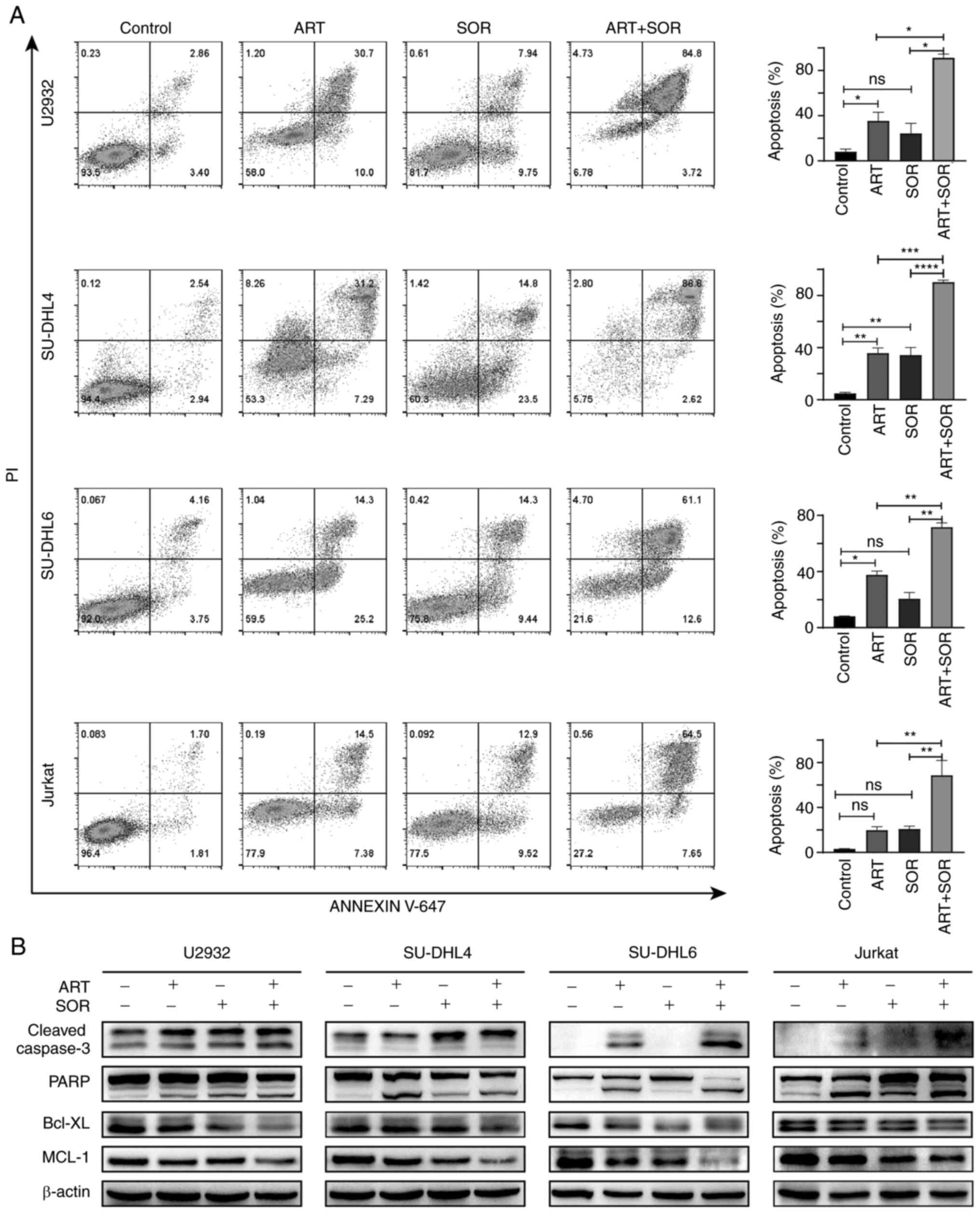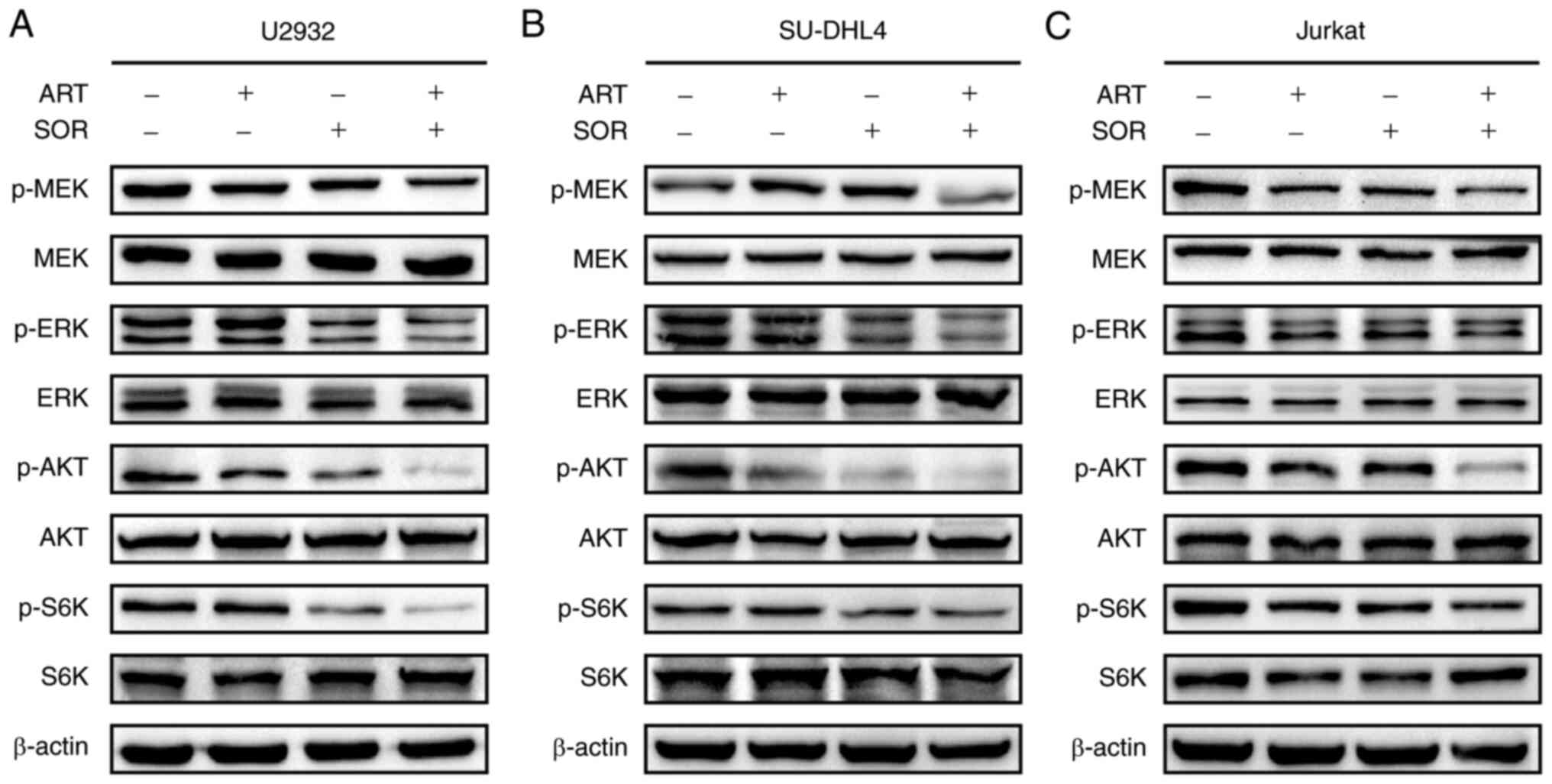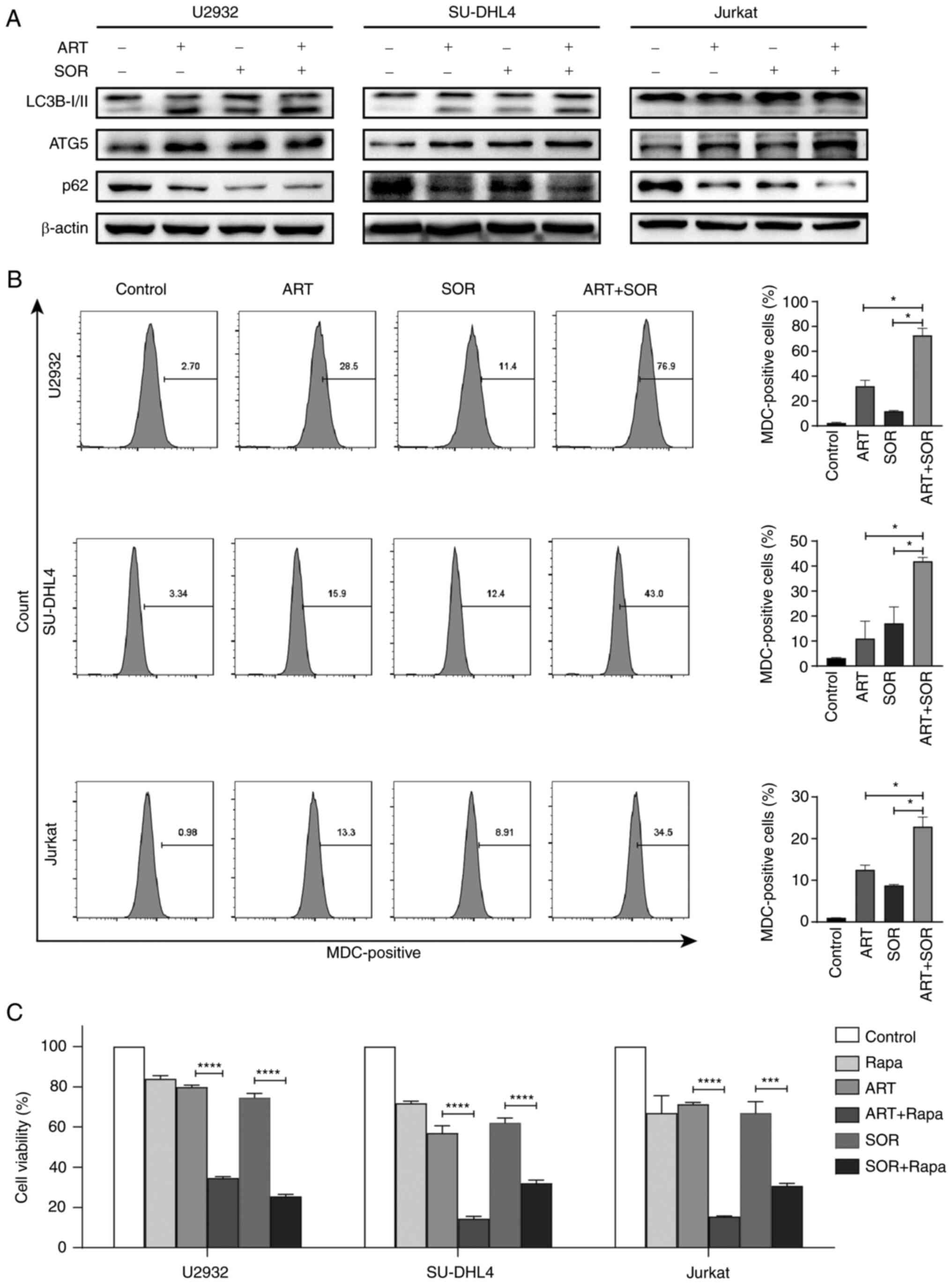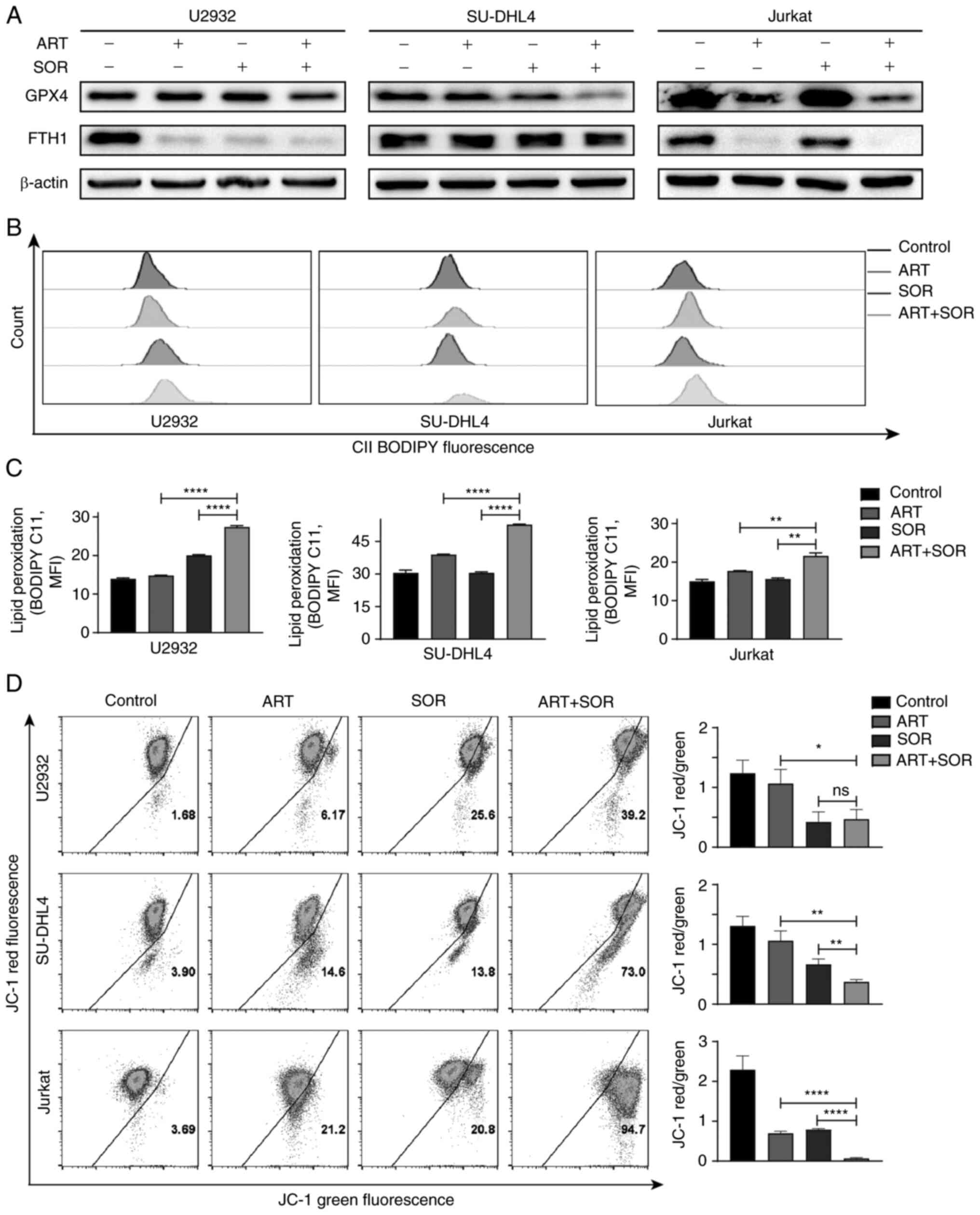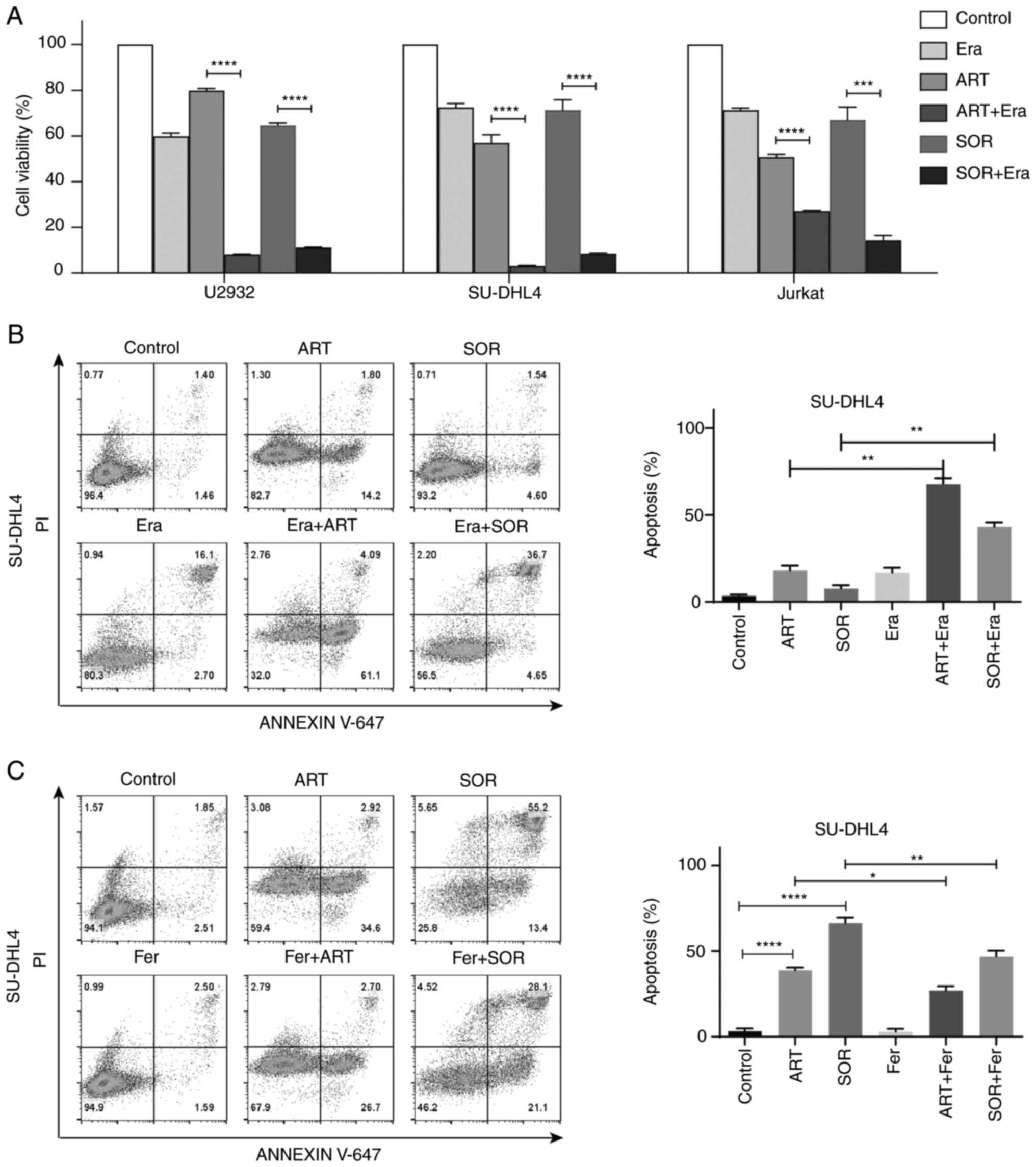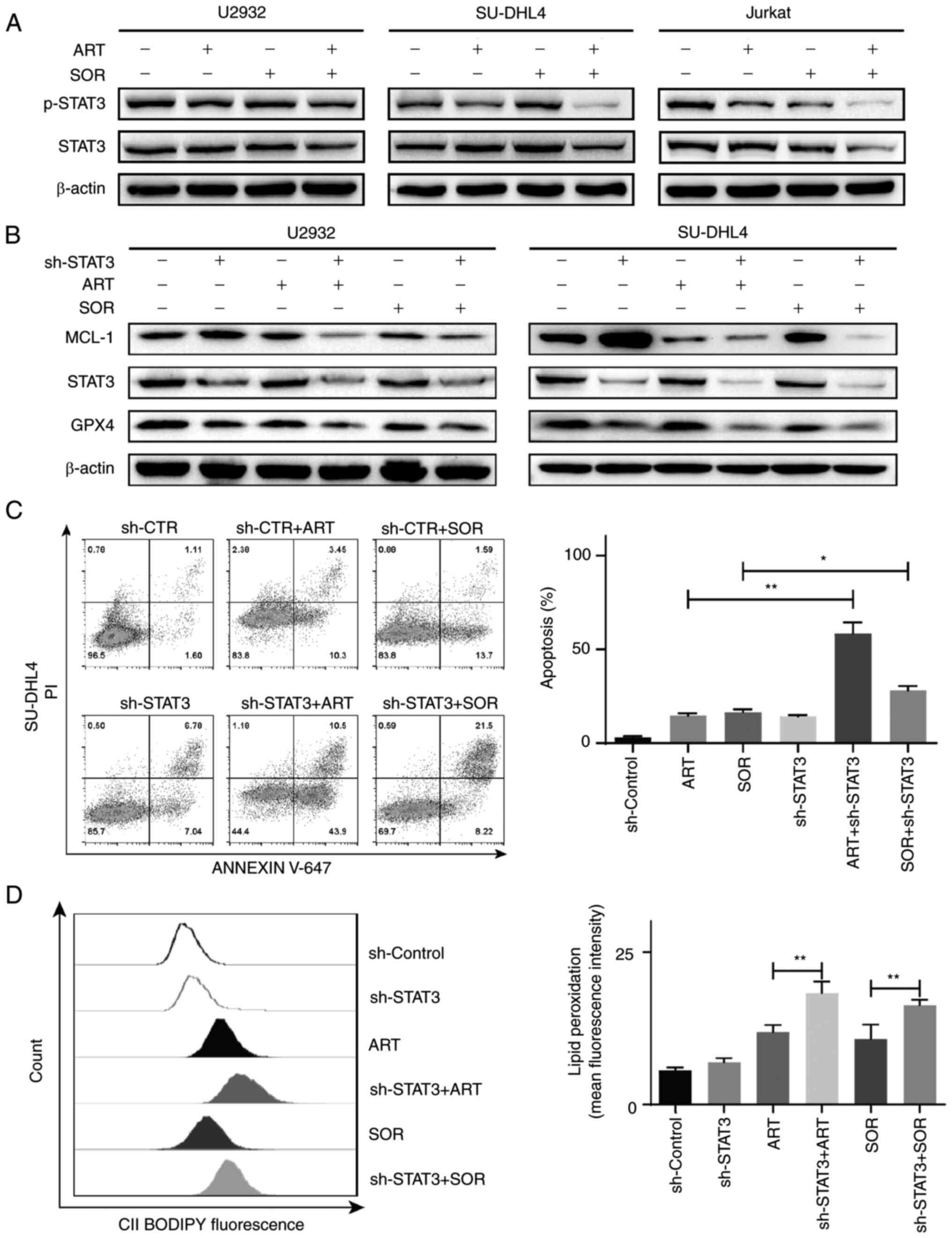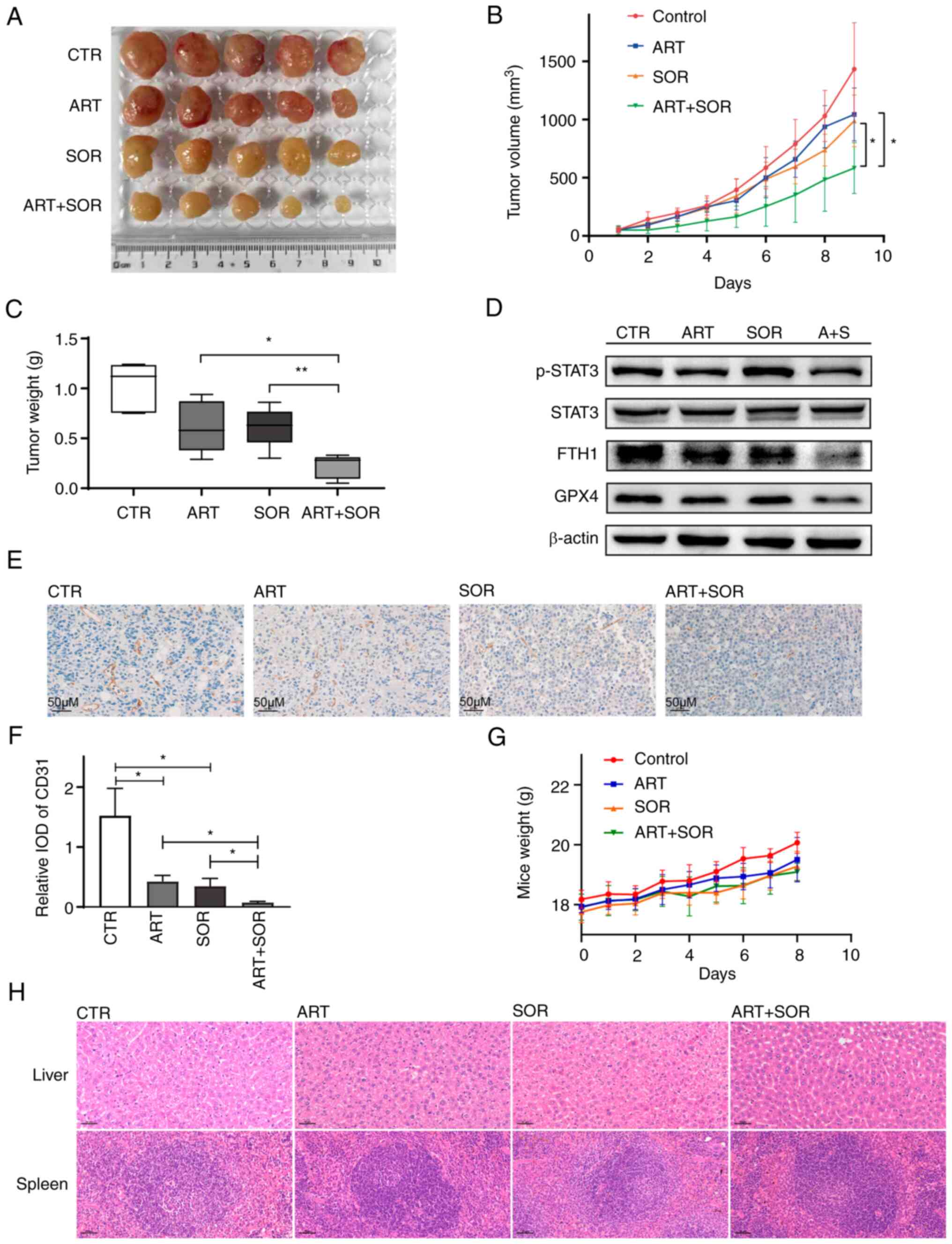|
1
|
Swerdlow SH, Campo E, Pileri SA, Harris
NL, Stein H, Siebert R, Advani R, Ghielmini M, Salles GA, Zelenetz
AD and Jaffe ES: The 2016 revision of the world health organization
classification of lymphoid neoplasms. Blood. 127:2375–2390. 2016.
View Article : Google Scholar : PubMed/NCBI
|
|
2
|
Shankland KR, Armitage JO and Hancock BW:
Non-hodgkin lymphoma. Lancet. 380:848–57. 2012. View Article : Google Scholar : PubMed/NCBI
|
|
3
|
Armitage JO, Gascoyne RD, Lunning MA and
Cavalli F: Non-hodgkin lymphoma. Lancet. 390:298–310. 2017.
View Article : Google Scholar : PubMed/NCBI
|
|
4
|
GBD 2017 Disease, Injury Incidence and
Prevalence Collaborators: Global, regional, and national incidence,
prevalence, and years lived with disability for 354 diseases and
injuries for 195 countries and territories, 1990–2017: A systematic
analysis for the global burden of disease study 2017. Lancet.
392:1789–1858. 2018. View Article : Google Scholar : PubMed/NCBI
|
|
5
|
GBD 2017 Causes of Death Collaborators, .
Global, regional, and national age-sex-specific mortality for 282
causes of death in 195 countries and territories, 1980–2017: A
systematic analysis for the global burden of disease study 2017.
Lancet. 392:1736–1788. 2018. View Article : Google Scholar : PubMed/NCBI
|
|
6
|
Liu W, Liu J, Song Y, Zeng X, Wang X, Mi
L, Cai C, Wang L, Ma J and Zhu J; Union for China Leukemia
Investigators of the Chinese Society of Clinical Oncology; Union
for China Lymphoma Investigators of the Chinese Society of Clinical
Oncology, : Burden of lymphoma in China, 2006–2016: An analysis of
the global burden of disease study 2016. J Hematol Oncol.
12:1152019. View Article : Google Scholar : PubMed/NCBI
|
|
7
|
White NJ: Qinghaosu (artemisinin): The
price of success. Science. 320:330–334. 2008. View Article : Google Scholar : PubMed/NCBI
|
|
8
|
Song X, Wei W, Cheng W, Zhu H, Wang W,
Dong H and Li J: Cerebral malaria induced by plasmodium falciparum:
Clinical features, pathogenesis, diagnosis, and treatment. Front
Cell Infect Microbiol. 12:9395322022. View Article : Google Scholar : PubMed/NCBI
|
|
9
|
Wei S, Liu L, Chen Z, Yin W, Liu Y, Ouyang
Q, Zeng F, Nie Y and Chen T: Artesunate inhibits the mevalonate
pathway and promotes glioma cell senescence. J Cell Mol Med.
24:276–284. 2020. View Article : Google Scholar : PubMed/NCBI
|
|
10
|
Raza A, Ghoshal A, Chockalingam S and
Ghosh SS: Connexin-43 enhances tumor suppressing activity of
artesunate via gap junction-dependent as well as independent
pathways in human breast cancer cells. Sci Rep. 7:75802017.
View Article : Google Scholar : PubMed/NCBI
|
|
11
|
Ishikawa C, Senba M and Mori N: Evaluation
of artesunate for the treatment of adult T-cell leukemia/lymphoma.
Eur J Pharmacol. 872:1729532020. View Article : Google Scholar : PubMed/NCBI
|
|
12
|
Våtsveen TK, Myhre MR, Steen CB, Wälchli
S, Lingjærde OC, Bai B, Dillard P, Theodossiou TA, Holien T, Sundan
A, et al: Artesunate shows potent anti-tumor activity in B-cell
lymphoma. J Hematol Oncol. 11:232018. View Article : Google Scholar : PubMed/NCBI
|
|
13
|
Song Q, Peng S, Che F and Zhu X:
Artesunate induces ferroptosis via modulation of p38 and ERK
signaling pathway in glioblastoma cells. J Pharmacol Sci.
148:300–306. 2022. View Article : Google Scholar : PubMed/NCBI
|
|
14
|
Markowitsch SD, Schupp P, Lauckner J,
Vakhrusheva O, Slade KS, Mager R, Efferth T, Haferkamp A and
Juengel E: Artesunate inhibits growth of sunitinib-resistant renal
cell carcinoma cells through cell cycle arrest and induction of
ferroptosis. Cancers (Basel). 12:31502020. View Article : Google Scholar : PubMed/NCBI
|
|
15
|
Zhang ZY, Yu SQ, Miao LY, Huang XY, Zhang
XP, Zhu YP, Xia XH and Li DQ: Artesunate combined with vinorelbine
plus cisplatin in treatment of advanced non-small cell lung cancer:
A randomized controlled trial. Zhong Xi Yi Jie He Xue Bao.
6:134–138. 2008.(In Chinese). View Article : Google Scholar : PubMed/NCBI
|
|
16
|
Trimble CL, Levinson K, Maldonado L,
Donovan MJ, Clark KT, Fu J, Shay ME, Sauter ME, Sanders SA, Frantz
PS and Plesa M: A first-in-human proof-of-concept trial of
intravaginal artesunate to treat cervical intraepithelial neoplasia
2/3 (CIN2/3). Gynecol Oncol. 157:188–194. 2020. View Article : Google Scholar : PubMed/NCBI
|
|
17
|
von Hagens C, Walter-Sack I, Goeckenjan M,
Storch-Hagenlocher B, Sertel S, Elsässer M, Remppis BA, Munzinger
J, Edler L, Efferth T, et al: Long-term add-on therapy
(compassionate use) with oral artesunate in patients with
metastatic breast cancer after participating in a phase I study
(ARTIC M33/2). Phytomedicine. 54:140–148. 2019. View Article : Google Scholar : PubMed/NCBI
|
|
18
|
Krishna S, Ganapathi S, Ster IC, Saeed ME,
Cowan M, Finlayson C, Kovacsevics H, Jansen H, Kremsner PG, Efferth
T and Kumar D: A randomised, double blind, placebo-controlled pilot
study of oral artesunate therapy for colorectal cancer.
EBioMedicine. 2:82–90. 2014. View Article : Google Scholar : PubMed/NCBI
|
|
19
|
Tang W, Chen Z, Zhang W, Cheng Y, Zhang B,
Wu F, Wang Q, Wang S, Rong D, Reiter FP, et al: The mechanisms of
sorafenib resistance in hepatocellular carcinoma: Theoretical basis
and therapeutic aspects. Signal Transduct Target Ther. 5:872020.
View Article : Google Scholar : PubMed/NCBI
|
|
20
|
Ravandi F, Alattar ML, Grunwald MR, Rudek
MA, Rajkhowa T, Richie MA, Pierce S, Daver N, Garcia-Manero G and
Faderl S: Phase 2 study of azacytidine plus sorafenib in patients
with acute myeloid leukemia and FLT-3 internal tandem duplication
mutation. Blood. 121:4655–4662. 2013. View Article : Google Scholar : PubMed/NCBI
|
|
21
|
Gibson JF, Foss F, Cooper D, Seropian S,
Irizarry D, Barbarotta L and Lansigan F: Pilot study of sorafenib
in relapsed or refractory peripheral and cutaneous T-cell lymphoma.
Br J Haematol. 167:141–144. 2014. View Article : Google Scholar : PubMed/NCBI
|
|
22
|
Kießling MK, Nicolay JP, Schlör T, Klemke
CD, Süss D, Krammer PH and Gülow K: NRAS mutations in cutaneous T
cell lymphoma (CTCL) sensitize tumors towards treatment with the
multikinase inhibitor sorafenib. Oncotarget. 8:45687–45697. 2017.
View Article : Google Scholar
|
|
23
|
Hamed HA, Tavallai S, Grant S, Poklepovic
A and Dent P: Sorafenib/regorafenib and lapatinib interact to kill
CNS tumor cells. J Cell Physiol. 230:131–139. 2015. View Article : Google Scholar : PubMed/NCBI
|
|
24
|
Chen Y, Wang F, Wu P, Gong S, Gao J, Tao
H, Shen Q, Wang S, Zhou Z and Jia Y: Artesunate induces apoptosis,
autophagy and ferroptosis in diffuse large B cell lymphoma cells by
impairing STAT3 signaling. Cell Signal. 88:1101672021. View Article : Google Scholar : PubMed/NCBI
|
|
25
|
Efferth T: From ancient herb to modern
drug: Artemisia annua and artemisinin for cancer therapy. Semin
Cancer Biol. 46:65–83. 2017. View Article : Google Scholar : PubMed/NCBI
|
|
26
|
Ruwizhi N, Maseko RB and Aderibigbe BA:
Recent advances in the therapeutic efficacy of artesunate.
Pharmaceutics. 14:5042022. View Article : Google Scholar : PubMed/NCBI
|
|
27
|
Zhao KC and Song ZY: Distribution and
excretion of artesunate in rats. Proc Chin Acad Med Sci Peking
Union Med Coll. 4:186–188. 1989.PubMed/NCBI
|
|
28
|
Clavreul A, Roger E, Pourbaghi-Masouleh M,
Lemaire L, Tétaud C and Menei P: Development and characterization
of sorafenib-loaded lipid nanocapsules for the treatment of
glioblastoma. Drug Deliv. 25:1756–1765. 2018. View Article : Google Scholar : PubMed/NCBI
|
|
29
|
Feng FB and Qiu HY: Effects of artesunate
on chondrocyte proliferation, apoptosis and autophagy through the
PI3K/AKT/mTOR signaling pathway in rat models with rheumatoid
arthritis. Biomed Pharmacother. 102:1209–1220. 2018. View Article : Google Scholar : PubMed/NCBI
|
|
30
|
Thomé MP, Filippi-Chiela EC, Villodre ES,
Migliavaca CB, Onzi GR, Felipe KB and Lenz G: Ratiometric analysis
of acridine orange staining in the study of acidic organelles and
autophagy. J Cell Sci. 129:4622–4632. 2016.PubMed/NCBI
|
|
31
|
Su Y, Zhao B, Zhou L, Zhang Z, Shen Y, Lv
H, AlQudsy LHH and Shang P: Ferroptosis, a novel pharmacological
mechanism of anti-cancer drugs. Cancer Lett. 483:127–136. 2020.
View Article : Google Scholar : PubMed/NCBI
|
|
32
|
Zhang W, Gong M, Zhang W, Mo J, Zhang S,
Zhu Z, Wang X, Zhang B, Qian W, Wu Z, et al: Thiostrepton induces
ferroptosis in pancreatic cancer cells through STAT3/GPX4
signalling. Cell Death Dis. 13:6302022. View Article : Google Scholar : PubMed/NCBI
|
|
33
|
Schmitt A, Xu W, Bucher P, Grimm M,
Konantz M, Horn H, Zapukhlyak M, Berning P, Brändle M, Jarboui MA,
et al: Dimethyl fumarate induces ferroptosis and impairs
NF-κB/STAT3 signaling in DLBCL. Blood. 138:871–884. 2021.
View Article : Google Scholar : PubMed/NCBI
|
|
34
|
Zhao X, Guo X, Yue W, Wang J, Yang J and
Chen J: Artemether suppresses cell proliferation and induces
apoptosis in diffuse large B cell lymphoma cells. Exp Ther Med.
14:4083–4090. 2017.PubMed/NCBI
|
|
35
|
Cheng C, Wang T, Song Z, Peng L, Gao M,
Hermine O, Rousseaux S, Khochbin S, Mi JQ and Wang J: Induction of
autophagy and autophagy-dependent apoptosis in diffuse large B-cell
lymphoma by a new antimalarial artemisinin derivative, SM1044.
Cancer Med. 7:380–396. 2018. View Article : Google Scholar : PubMed/NCBI
|
|
36
|
Wang N, Zeng GZ, Yin JL and Bian ZX:
Artesunate activates the ATF4-CHOP-CHAC1 pathway and affects
ferroptosis in burkitt's lymphoma. Biochem Biophys Res Commun.
519:533–539. 2019. View Article : Google Scholar : PubMed/NCBI
|
|
37
|
Xargay-Torrent S, López-Guerra M,
Montraveta A, Saborit-Villarroya I, Rosich L, Navarro A,
Pérez-Galán P, Roué G, Campo E and Colomer D: Sorafenib inhibits
cell migration and stroma-mediated bortezomib resistance by
interfering B-cell receptor signaling and protein translation in
mantle cell lymphoma. Clin Cancer Res. 19:586–597. 2013. View Article : Google Scholar : PubMed/NCBI
|
|
38
|
Locatelli SL, Cleris L, Stirparo GG,
Tartari S, Saba E, Pierdominici M, Malorni W, Carbone A, Anichini A
and Carlo-Stella C: BIM upregulation and ROS-dependent necroptosis
mediate the antitumor effects of the HDACi givinostat and sorafenib
in hodgkin lymphoma cell line xenografts. Leukemia. 28:1861–1871.
2014. View Article : Google Scholar : PubMed/NCBI
|
|
39
|
Carlo-Stella C, Locatelli SL, Giacomini A,
Cleris L, Saba E, Righi M, Guidetti A and Gianni AM: Sorafenib
inhibits lymphoma xenografts by targeting MAPK/ERK and AKT pathways
in tumor and vascular cells. PLoS One. 8:e616032013. View Article : Google Scholar : PubMed/NCBI
|
|
40
|
Ramakrishnan V, Timm M, Haug JL, Kimlinger
TK, Halling T, Wellik LE, Witzig TE, Rajkumar SV, Adjei AA and
Kumar S: Sorafenib, a multikinase inhibitor, is effective in vitro
against non-Hodgkin lymphoma and synergizes with the mTOR inhibitor
rapamycin. Am J Hematol. 87:277–283. 2012. View Article : Google Scholar : PubMed/NCBI
|
|
41
|
Locatelli SL, Giacomini A, Guidetti A,
Cleris L, Mortarini R, Anichini A, Gianni AM and Carlo-Stella C:
Perifosine and sorafenib combination induces mitochondrial cell
death and antitumor effects in NOD/SCID mice with Hodgkin lymphoma
cell line xenografts. Leukemia. 27:1677–1687. 2013. View Article : Google Scholar : PubMed/NCBI
|
|
42
|
Takashima Y, Hayano A and Yamanaka R:
Metabolome analysis reveals excessive glycolysis via PI3K/AKT/mTOR
and RAS/MAPK signaling in methotrexate-resistant primary CNS
lymphoma-derived cells. Clin Cancer Res. 26:2754–2766.
2020.PubMed/NCBI
|
|
43
|
Jiang F, Zhou JY, Zhang D, Liu MH and Chen
YG: Artesunate induces apoptosis and autophagy in HCT116 colon
cancer cells, and autophagy inhibition enhances the
artesunateinduced apoptosis. Int J Mol Med. 42:1295–1304.
2018.PubMed/NCBI
|
|
44
|
Zhou X, Chen Y, Wang F, Wu H, Zhang Y, Liu
J, Cai Y, Huang S, He N, Hu Z and Jin X: Artesunate induces
autophagy dependent apoptosis through upregulating ROS and
activating AMPK-mTOR-ULK1 axis in human bladder cancer cells. Chem
Biol Interact. 331:1092732020. View Article : Google Scholar : PubMed/NCBI
|
|
45
|
Shimizu S, Takehara T, Hikita H, Kodama T,
Tsunematsu H, Miyagi T, Hosui A, Ishida H, Tatsumi T, Kanto T, et
al: Inhibition of autophagy potentiates the antitumor effect of the
multikinase inhibitor sorafenib in hepatocellular carcinoma. Int J
Cancer. 131:548–557. 2012. View Article : Google Scholar : PubMed/NCBI
|
|
46
|
Heqing Y, Bin L, Xuemei Y and Linfa L: The
role and mechanism of autophagy in sorafenib targeted cancer
therapy. Crit Rev Oncol Hematol. 100:137–140. 2016. View Article : Google Scholar : PubMed/NCBI
|
|
47
|
Liang C, Zhang X, Yang M and Dong X:
Recent progress in ferroptosis inducers for cancer therapy. Adv
Mater. 31:e19041972019. View Article : Google Scholar : PubMed/NCBI
|
|
48
|
Hassannia B, Vandenabeele P and Vanden
Berghe T: Targeting ferroptosis to iron out cancer. Cancer Cell.
35:830–849. 2019. View Article : Google Scholar : PubMed/NCBI
|
|
49
|
Mou Y, Wang J, Wu J, He D, Zhang C, Duan C
and Li B: Ferroptosis, a new form of cell death: Opportunities and
challenges in cancer. J Hematol Oncol. 12:342019. View Article : Google Scholar : PubMed/NCBI
|
|
50
|
Yang WS, SriRamaratnam R, Welsch ME,
Shimada K, Skouta R, Viswanathan VS, Cheah JH, Clemons PA, Shamji
AF, Clish CB, et al: Regulation of ferroptotic cancer cell death by
GPX4. Cell. 156:317–331. 2014. View Article : Google Scholar : PubMed/NCBI
|
|
51
|
Li J, Cao F, Yin HL, Huang ZJ, Lin ZT, Mao
N, Sun B and Wang G: Ferroptosis: Past, present and future. Cell
Death Dis. 11:882020. View Article : Google Scholar : PubMed/NCBI
|
|
52
|
Zhang Y, Tan H, Daniels JD, Zandkarimi F,
Liu H, Brown LM, Uchida K, O'Connor OA and Stockwell BR: Imidazole
ketone erastin induces ferroptosis and slows tumor growth in a
mouse lymphoma model. Cell Chem Biol. 26:623–633.e9. 2019.
View Article : Google Scholar : PubMed/NCBI
|
|
53
|
Tang D, Tang D, Kang R, Berghe TV,
Vandenabeele P and Kroemer G: The molecular machinery of regulated
cell death. Cell Res. 29:347–364. 2019. View Article : Google Scholar : PubMed/NCBI
|
|
54
|
Galluzzi L, Vitale I, Aaronson SA, Abrams
JM, Adam D, Agostinis P, Alnemri ES, Altucci L, Amelio I, Andrews
DW, et al: Molecular mechanisms of cell death: Recommendations of
the nomenclature committee on cell death 2018. Cell Death Differ.
25:486–541. 2018. View Article : Google Scholar : PubMed/NCBI
|
|
55
|
Lee Y, Lee DH, Choudry HA, Bartlett DL and
Lee YJ: Ferroptosis-induced endoplasmic reticulum stress:
Cross-talk between ferroptosis and apoptosis. Mol Cancer Res.
16:1073–1076. 2018. View Article : Google Scholar : PubMed/NCBI
|
|
56
|
Zhu F, Wang KB and Rui L: STAT3 activation
and oncogenesis in lymphoma. Cancers (Basel). 12:192019. View Article : Google Scholar : PubMed/NCBI
|
|
57
|
Lobello C, Tichy B, Bystry V, Radova L,
Filip D, Mraz M, Montes-Mojarro IA, Prokoph N, Larose H and Liang
HC: STAT3 and TP53 mutations associate with poor prognosis in
anaplastic large cell lymphoma. Leukemia. 35:1500–1505. 2021.
View Article : Google Scholar : PubMed/NCBI
|



